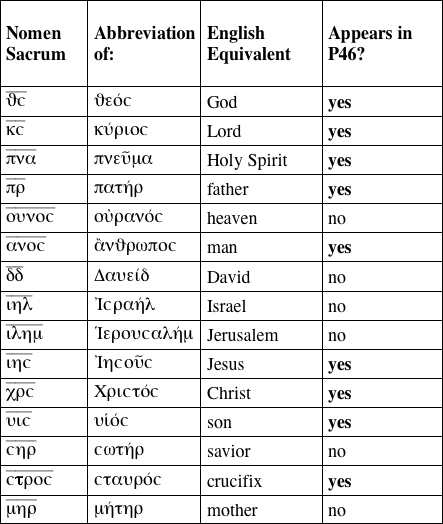

Nomina sacra are special abbreviations which appear in New Testament texts. Unlike most abbreviations, which are meant to save time (see Abbreviations in P46), nomina sacra are used to set certain, holy words apart from the rest of the text. This is clear from the fact that these words are abbreviated in their sacral usages but not in profane usages (e.g. ὑΐοϲ, 'son' is contracted to υϲ when it refers to Jesus, the Son of God, but the same word is not contracted in other usages).
 |
 |
example 1: θϲ |
example 2: υιϲ |
The letters used in nomina sacra were not the first few letters of the word (as in other forms of abbreviation), but were usually the first and last letter (as in θϲ for θεόϲ, "god") or a selection of indicative letters (as in ϲτροϲ for ϲταυρόϲ, "cross"). Because the last letter or two is retained, the grammatical case of the word is clear (e.g. θϲ for θεόϲ, but θυ for θεοῦ, θω for θεῷ, and θν for θεόν).
The precise origins of the use of nomina sacra remain unclear, but their use is pervasive throughout New Testament writing, growing in scope over time to include more words, and the practice is even retained in the Latin and Coptic New Testament traditions. Because of its early date, P46 shows some of the earliest forms of nomina sacra, using certain three-letter abbreviations (e.g. ιηϲ) rather than the two-letter forms (e.g. ιϲ) which began to replace them in the fourth century. Also, P46 only uses nomina sacra for a subset of the list of words which eventually came to be contracted. Below is a list of nomina sacra, showing whether they appear in P46 or not.

The fact that some nomina sacra are not attested in P46 is a result of the early date at which this codex was produced. The list of nomina sacra grew over the centuries, and it is to be expected that an early codex like this one would contain only the early forms of nomina sacra.
For a fuller discussion of nomina sacra, see Paap, A.H.R.E., Nomina Sacra in the Greek Papyri of the First Five Centuries. Papyrologica Lugduno-Batava VIII (Leiden 1959).